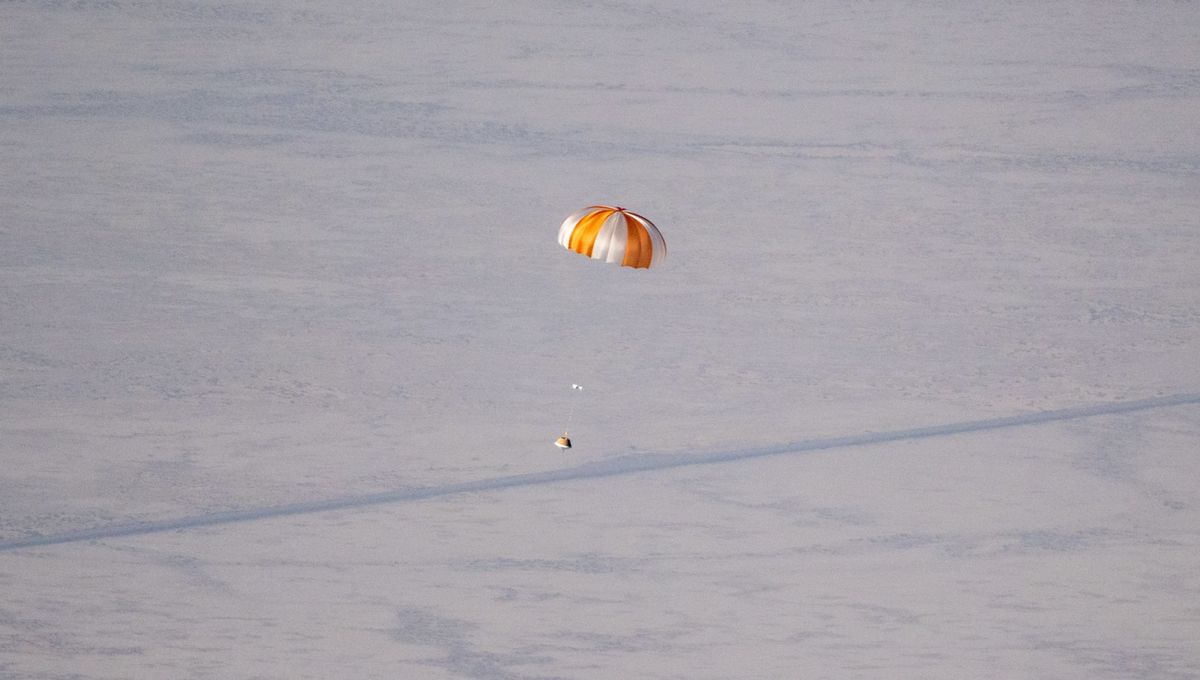
Almost three years after touching the surface of asteroid Bennu, NASA’s OSIRIS-REx is coming back to Earth. The spacecraft is bringing back a sample collected during that incredible encounter and is scheduled to drop its precious cargo in the Utah desert on Sunday, making it the first-ever US mission to bring a piece of an asteroid back to Earth.
Bennu, a spinning top-shaped space rock about half a kilometer wide, is the most dangerous known “potentially hazardous” asteroid (although don’t be too worried). It’s thought it has changed very little since the formation of the Solar System and studying its properties might give us a glimpse into the time of the birth of the planets. Asteroids like Bennu may have even brought water and the ancient building blocks of life to Earth.
The mission team has been rehearsing the retrieval for months now. Showtime is September 24 at about 8:42 am local time (2:42 pm UTC). The capsule will enter the atmosphere, deploy a parachute, and land within a certain area of the US Air Force’s Utah Test and Training Range. The capsule will then be taken to a special kitted-up room to avoid contamination where it will be processed, items like the heat shield and back shell will be removed, and nitrogen will be used to remove oxygen and moisture from the sample canister.
It will then be taken down to NASA’s Johnson Space Center – and that’s where the science will begin. The sample will be opened in a specialized cleanroom and inside a glovebox. From there, portions of the sample will be given to research institutes that request it. The team estimates they have more than the required 60 grams; in fact, NASA estimates that between 400 and 1,000 grams (14-35 ounces) of material were collected. So, there is plenty of it to go around.
“I’m very interested in the arrival of the specimens from the asteroid Bennu. This will be the largest specimen we’ve received from an asteroid to date,” Brother Bob Macke, the curator of meteorites at the Vatican Observatory, told IFLScience.
Macke has developed a pycnometer, a device to measure the volume and thus the density and porosity of cosmic material. Assessing those characteristics will provide a clear idea of how Bennu came to be. The expectation was that the asteroid would be covered in sand-like soil; instead, OSIRIS-REx discovered a lot of boulders.
The finer material that would be easier to scoop up was found in craters and depressions on the surface. Reaching down there was a risky move, though. The whole asteroid is a big rubble pile, loosely held together by gravity. So loosely, in fact, that OSIRIS-REx was almost gobbled up by Bennu – like sinking in a ball pit.
“It became apparent the material that we could collect was in these really small bowl-shaped craters, which the spacecraft team was not excited about sending the spacecraft into. But immediately I was like, we have to figure out how to get into one of these craters. And it was the stereo images that [allowed it], that was my ‘Wow’ moment,” Dante Lauretta, principal investigator of OSIRIS-REx, told IFLScience.
The 3D stereoscopic images of Bennu that led to finding a mostly safe location to land and scoop up a sample were produced by astrophysicist and rockstar Sir Brian May and his collaborator Claudia Manzoni, which May and Lauretta published as a stereoscopic book, where the asteroid’s odd structure can be clearly seen.
The peculiar composition of Bennu is one of the reasons why it was chosen as the first US asteroid sample-return mission. Bennu is like a time capsule from the birth of the Solar System, a primitive object that might tell us more about the conditions of our corner of the universe at the time of the formation of our planet.
But the sample from Bennu will also contextualize the other ways we study the time of the formation of the Solar System: meteorites. While some meteorites are from the Moon and Mars (although maybe one came from Earth), a lot of them come from asteroids. Unfortunately, we remain ignorant of what type of asteroids they came from and where in the Solar System they are. The sample will help clarify some of those unknowns.
“To go to the next step in meteorite research, we really need to have that context: Both the geological context of what rocks were around the sample that we’ve got, but also the astronomical context, knowing the whereabouts in the Solar System the sample came,” Professor Sara Russell, part of the OSIRIS-REx Sample Analysis Team from the Natural History Museum, London, told IFLScience.
“Space missions [like OSIRIS-REx] are like fieldwork for meteoricists. They’re like the next step that will enable us to learn more about these really important rocks, and what they can tell us about the beginning of the Solar System.”
After dropping off its cargo, the mission will change its name to become OSIRIS-APEX, continuing towards another Near-Earth object, asteroid Apophis, which it will reach in 2029.
Source Link: This Week A Piece Of The Most Dangerous Asteroid Will Land In America